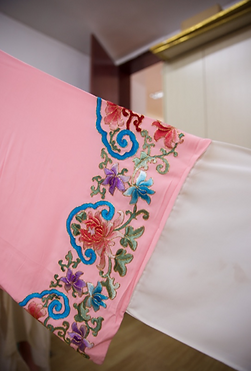Eunice Tan
Understand Chinese Opera Without Hearing A Word
How-to | September 2019
Photos by: Suzannah Lum, Russell Lee and Eunice Tan
Eunice Tan discovers the meaning behind Chinese Opera costumes, a language that
expresses like the spoken word.
Despite its name being Chinese Opera, the language spoken in the traditional art form is not Chinese. Thus, you do not even need to understand Chinese or any dialect to appreciate it.
You can understand a performance without hearing a single word. The language of opera does not lie in the spoken word alone, but also lies in the makeup and costume.
One of the main ways to appreciate and understand Chinese opera is through the symbolisms in its costumes. Through their attire, you can recognize the character’s social status, personality, age and even ethnicity. Mr Zhang Rui, Troupe Leader of the Hubei Chu Opera Academy, shares his knowledge on opera costumes.
Firstly, you can recognize the age or status of the character through the colours of the costumes.


Dull Colours
Typically, beige colours are worn by characters of lowest social rankings while dark hues, such as purple and army green, are for older characters regardless of their ranking.
Bright Colours
Younger characters, such as scholars, adorn brighter colours such as blue and pink especially if they come from well-to-do families. However, youths from poor families tend to wear black.


Specific Colours


Some shades, such as red and yellow, have specific symbolisms.
Red, despite being commonly known as a loud colour, represents more delicate and elegant characteristics.
If you spot a character in yellow, you won’t be able to mix him up with others. Yellow can only be worn by the emperor because yellow in Chinese, Huang, sounds like emperor, Huang Di.


If you are looking out for the emperor, know that despite dragons symbolising position and power, the size of the dragon does not correspond to that. A larger dragon could also represent the loud and fierce personality of a character.
Flower Motifs


Another aspect of costumes to observe are the motifs of flowers. The more elaborate and detailed the embroidered flower patterns are, the higher the status of the character.
The way the flowers are placed represents various things. For example, scattered flowers represent the comics, Hua Hua Chang Zi, and playboys, Hua Hua Gong Zi. These characters have playful personalities and fool around, the kind that would make you laugh. On the other hand, clustered flowers on collars symbolise a higher status and serious character.


The species of flowers used also have a purpose. For instance, Mu Dan, Peonies, are for the wealthy, while Lan Hua, Orchids, expresses the resilience of a character.


A unique pattern is the Tang Hua, incorporating of delicate curves of flowers and harsh angles of branch-like squares. It represents wealth and can only be seen on wives of officials.
Chinese opera is commonly thought to be enjoyed only by the older generations. However, with understanding of a language that speaks more than word itself, you are sure to discover a newfound appreciation for Chinese Opera - which isn’t just an art loved by your grandmother.